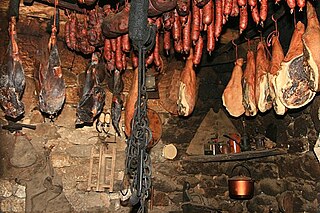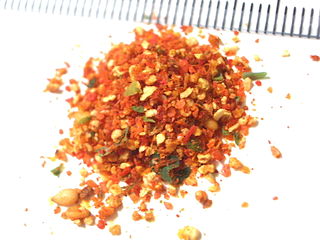
A condiment or table sauce is a spice, sauce, or preparation that is added to food to impart a specific flavor, to enhance the flavor, or, in some cultures, to complement the dish. The term originally described pickled or preserved foods, but its meaning has changed over time.

Cookware and bakeware are types of food preparation containers, commonly found in a kitchen. Cookware comprises cooking vessels, such as saucepans and frying pans, intended for use on a stove or range cooktop. Bakeware comprises cooking vessels intended for use inside an oven. Some utensils are considered both cookware and bakeware.

A crouton is a piece of sautéed or rebaked bread, often cubed and seasoned, that is used to add texture and flavor to salads—notably the Caesar salad—as an accompaniment to soups and stews, or eaten as a snack food.

Oak is used in winemaking to vary the color, flavor, tannin profile and texture of wine. It can be introduced in the form of a barrel during the fermentation or aging periods, or as free-floating chips or staves added to wine fermented in a vessel like stainless steel. Oak barrels can impart other qualities to wine through evaporation and low level exposure to oxygen.

Jerk is a style of cooking native to Jamaica, in which meat is dry-rubbed or wet marinated with a hot spice mixture called Jamaican jerk spice.

Smoked meat is a method of preparing red meat which originates in prehistory. Its purpose is to preserve these protein-rich foods, which would otherwise spoil quickly, for long periods. There are two mechanisms for this preservation: dehydration and the antibacterial properties of phenols and other chemicals in the absorbed smoke. In modern days, the enhanced flavor of smoked foods makes them a delicacy in many cultures.

Clay pot cooking is a process of cooking food in a pot made of unglazed or glazed pottery.

Shichi-mi tōgarashi , also known as nana-iro tōgarashi or simply shichimi, is a common Japanese spice mixture containing seven ingredients.

Kosher salt or kitchen salt is coarse edible salt without common additives such as iodine. Used in cooking and not at the table, it consists mainly of sodium chloride and may include anticaking agents.
Cooking spray is a spray form of an oil as a lubricant, lecithin as an emulsifier, and a propellant such as food-grade alcohol, nitrous oxide, carbon dioxide or propane. Cooking spray is applied to frying pans and other cookware to prevent food from sticking. Traditionally, cooks used butter, shortening, or oils poured or rubbed on cookware. Most cooking sprays have less food energy per serving than an application of vegetable oil, because they are applied in a much thinner layer: US regulations allow many to be labelled "zero-calorie"; in the UK sprays claim to supply "less than 1 calorie per serving". Popular US brands include Pam, Crisco, and Baker's Joy. Sprays are available with plain vegetable oil, butter and olive oil flavor.

Onion powder is dehydrated, ground onion that is commonly used as a seasoning. It is a common ingredient in seasoned salt and spice mixes, such as beau monde seasoning. Some varieties are prepared using toasted onion. White, yellow and red onions may be used. Onion powder is a commercially prepared food product that has several culinary uses. Onion powder can also be homemade.

Cast-iron cookware is valued for its heat retention properties and can be produced and formed with a relatively low level of technology. Seasoning is used to protect bare cast iron from rust and to create a non-stick surface. Types of bare cast-iron cookware include panini presses, waffle irons, crepe makers, dutch ovens, frying pans, deep fryers, tetsubin, woks, potjies, karahi, flattop grills and griddles.
Amchoor or aamchur, also referred to as mango powder, is a fruity spice powder made from dried unripe green mangoes and is used as a citrusy seasoning. It is produced in India, and is used to flavor foods and add the nutritional benefits of mangoes when the fresh fruit is out of season.

Crab boil usually refers to a spice mixture that is used to flavor the water in which crabs or other shellfish are boiled. But Crab boil can also refer to a social event in which boiled crabs are featured. Crab boils are known in the Ville Platte areas of Louisiana as "dome lobster boils," stemming from the local term "dome lobster" based on the shape and composition of crabs and their likeness to a domed lobster. The largest of these gatherings is the Crayon d'Orange festival in Evangeline Parish.

Deep Fried Peanuts are a snack food created by deep frying peanuts in an oil. The resulting product is a snack food that can be eaten in its entirety, both shell and nut. The deep-frying process does not change the flavor or texture of the nutmeats, but changes the texture and flavor of the shells -- especially if seasonings are used -- to make them more palatable.

Popcorn seasoning can refer to a variety of seasonings that are used to add flavor to popcorn. In the United States, popcorn seasoning is mass-produced by several companies for commercial and consumer use. Popcorn seasonings may be used to enhance the flavor of popcorn, and some are used to add a buttery flavor to popcorn. Significant amounts are often used to ensure the adequate flavoring of popcorn, due to popcorn's low density. It is also sometimes utilized to add coloring to popcorn. Some popcorn seasoning may contain monosodium glutamate. Some specialty products exist in unique flavors, such as chocolate and bubble gum. Some popcorn seasoning products may be referred to as popcorn salt.

A tortilla press is a traditional device with a pair of flat round surfaces of about 8-inch plus to crush balls of corn dough in order to obtain round corn tortillas. Corn tortillas are pressed out between sheets of plastic or corn leaves. Tortilla presses are usually made of cast iron, cast aluminium or wood.
















